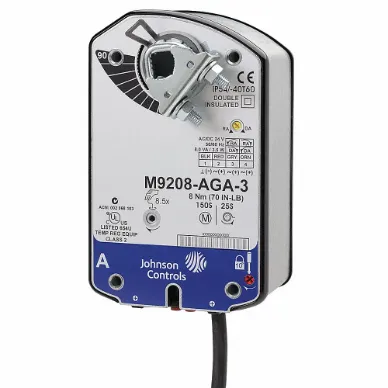Johnson Controls M9208-GGA-3 proportional actuator is effective in control systems to regulate any HVAC process by continuously adjusting its output in proportion to a control signal.
Working Mechanism:
- The actuator receives a control signal (voltage, current or digital commands) that represents the desired position or level for the system it is controlling.
- It measures the difference between the desired position (setpoint) and the current position of the system (feedback).
- This difference is called the 'error'.
- The actuator then adjusts its output in proportion to the calculated error.
Features:
- Johnson Controls M9208-GGA-3 proportional actuator has proportional control functionality for precise modulation of dampers.
- Its mechanical spring return system allows the actuator to maintain its rated torque (70 lb-inch) even in the absence of power.
- Johnson Controls M9208-GGA-3 proportional actuator offers On / Off, floating point and proportional control to cater to different system requirements and control strategies.
- Its quick power-on run time (150 seconds) not only enhances the efficiency of the control system but also ensures rapid response while adjusting the dampers.
- This actuator can be installed using the included 48-inch long appliance cable.
Compatible Accessories:
Frequently Asked Questions:
Q. Can Johnson Controls M9208-GGA-3 proportional actuator handle severe power outages?
A. Yes, it is equipped with a mechanical spring return system that maintains torque and ensures fail-safe operation by providing control over dampers even during power outages.
Q. How do I choose the right proportional actuator for my application?
A. Choosing the right proportional actuator involves considering factors like:
- Required precision and accuracy
- Desired range of motion or force
- Environmental conditions (temperature & humidity)
- Integration with existing control systems
- Power supply and voltage compatibility
Q. What is the difference between open-loop and closed-loop control in proportional actuators?
A. Open-loop control involves sending a control signal to the actuator without receiving feedback on the system's actual state. Closed-loop (feedback) control, on the other hand, incorporates information from sensors to adjust the actuator's output in real time.
 Change Country
Change Country
